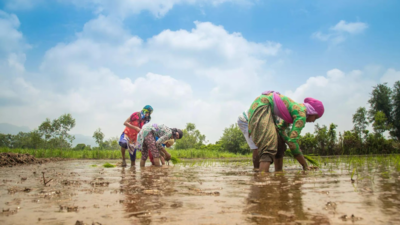

NEW DELHI: A development that is expected to help farmers better plan their sowing and harvesting schedule and prepare for climate-related risks, the central government on Thursday launched the “gram panchayat level weather forecasting” initiative that will enable residents of the over 2.5 lakh gram panchayats to have access to localised weather information with a five-day weather forecast and hourly updates.
The initiative, projected by government as a measure for boosting local-level governance and making villages climate-resilient, has been brought about by the ministry of panchayati raj (MoPR), in collaboration with the Indian Meteorological Department (IMD). According to the MoPR this is the first time that localised weather forecasts will be available at the gram panchayat level, supported by IMD’s expanded sensor coverage.
Panchayati Raj minister Rajiv Ranjan Singh said connecting gram panchayats to realtime weather forecasting is a “key step towards empowering the Indian economy and enhancing the ease of living for rural populations”. He also highlighted that this will help reduce agricultural losses due to weather uncertainties.
Earth sciences minister Dr Jitendra Singh pointed out that this initiative is part of the government’s broader commitment to strengthen the rural economy. “This initiative will also ensure that farmers and common citizens receive timely updates, helping them make informed decisions to improve both productivity and safety,” he added.
The forecasts will be disseminated through the Panchayati Raj ministry’s digital platforms: e-GramSwaraj, which enables efficient governance, project tracking, and resource management; the Meri Panchayat App, which fosters community engagement by allowing citizens to interact with local representatives and report issues; and Gram Manchitra, a spatial planning tool that provides geospatial insights for development projects.
“Gram Panchayats will receive daily updates on temperature, rainfall, wind speed, and cloud cover, empowering them to make critical decisions in agriculture, such as planning sowing, irrigation, and harvesting activities,” MoPR highlighted in a statement.
“These tools will also strengthen disaster preparedness and infrastructure planning. Furthermore, SMS alerts will be sent to Panchayat representatives regarding extreme weather events like cyclones and heavy rainfall, ensuring immediate action to protect lives, crops, and property,” the ministry explained in the statement.
Vivek Bharadwaj, secretary, MoPR, also shared that the ministry is working on a pilot to train locals at the panchayat level to be the first line of response in a disaster situation. MoPR will be collaborating with the National Disaster Management Authority to start a pilot in 27 districts across the country where locals will be trained and provided with some specialised equipment to help create a localised disaster response system at the grassroots.







